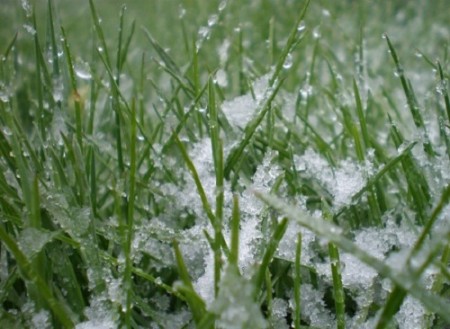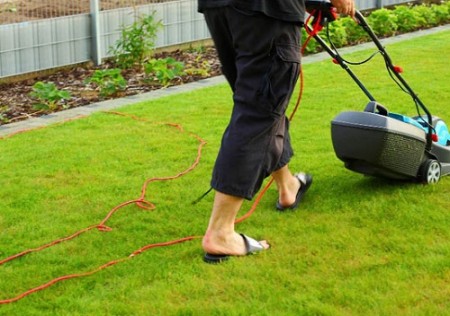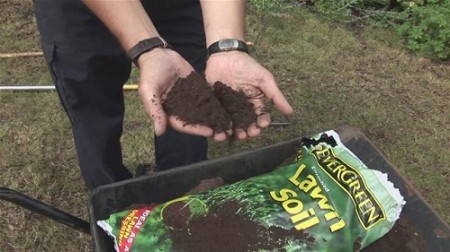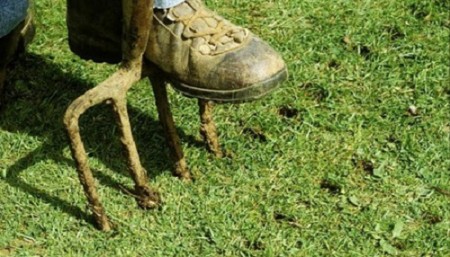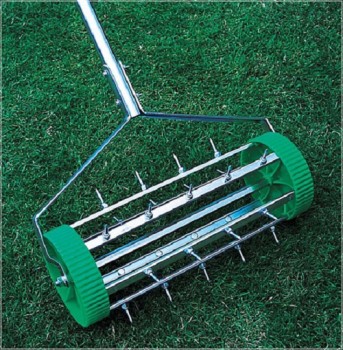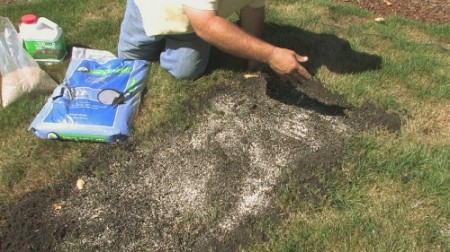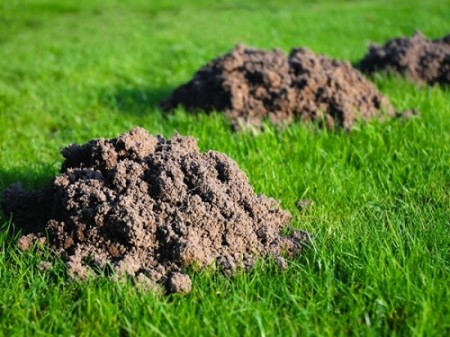A neat, well-groomed green lawn will give your suburban area a finished look, shade and make the other elements of the decor of the territory brighter and more saturated: trees, pond, flowers, shrubs, alpine hills. Lawn needs constant care throughout the warm season. With the advent of autumn, your grassy carpet must be properly prepared for wintering. What and how to do this, we'll talk about in this article.
Content
Do you need to prepare the lawn for winter?
It would seem - why? This is the usual grass, which in winter conditions perfectly hibernates without any preparation. All this is true, but we are talking about lawn grass, which is more "tender", and if you do not take care of the lawn in the fall, then in the spring it can "please" you with numerous bald spots, or the grass will have to be sown again. This is especially true for lawns, which are waiting for the first winter.
Necessary tools and materials
- Lawn mower or motocross trimmer.
- Garden forks or aerator.
- Fan rake.
- Fertilizers - about 3 kg per 100 sq. M.
- Seeds of lawn grass for sowing
How to prepare a lawn for winter
In the beginning of autumn, in September, when the summer heat drops and there is enough rainfall, regular watering of the lawn is not necessary. But if September turned out dry, you can water the lawn by sprinkling. Remember that moisture evaporates in autumn much worse than in summer, do not allow the formation of puddles in the grass.
Every gardener with experience begins to prepare his lawn for winter already from the beginning of September. Preparatory work is conducted until the first frost. In early October, it is recommended to completely water the lawn in order to avoid the accumulation of excess moisture in the ground. If this is not done, the grass can weaken, get sick and disappear.
last hairstyle of the lawn
As is known to all owners of lawns, in the summer the grass has to be cut almost every week. When autumn comes, the earth begins to cool down, plant growth slows down and this procedure does not happen so often. But to neglect a hairstyle of a lawn before the winter it is impossible. If the grass grows strong, then with the onset of frost it will freeze and fall to the ground. In the spring, this carpet of dead plants will be difficult to remove, and it will greatly interfere with young shoots. Therefore, caring for a lawn in the autumn includes the obligatory shearing of grass.
The most suitable mowing height is about five centimeters. After that, for several weeks, the lawn will grow by 2-3 centimeters. Such a height of the grass cover best accompanies the preservation of forces and nutrients for the forthcoming wintering.
How many times it is necessary to cut a lawn in the autumn, it is rather difficult to guess. If you mow the lawn in early September, then the grass, it is possible, will grow, and it will have to be cut again. Or the opposite situation is possible, when early frosts strike, and you do not have time to mow the grass for the winter. In the northern regions of the country mowing the lawn for the winter is best at about the end of September, in the middle belt in late September - early October, in the south - in the middle and even the end of October.
Cut grass should not be thrown away, but used as a fertilizer. Thus, you solve the problem of utilization of herbal mass, and at the same time reduce the amount of spring work in the garden or bed. If you follow the general recommendations of experienced gardeners, then the last mowing should be done about two to three weeks before the first frost in your region.
top dressing
In order for plants to recover faster after winter frosts and go into stable growth, they must be supplemented with mineral fertilizers. As for the composition of fertilizers, there is no unanimity here. Some gardeners recommend fertilizing the lawn in the fall using phosphorus and potassium fertilizers. You can agree with them, as phosphorus and potassium stimulate the rooting of the grass. Others advise to use nitrogen fertilizers, which contribute to the rapid development of green mass. Ideally, you need to combine all these types of fertilizers in the right proportions.
It will be superfluous to feed the lawn with nitrogen fertilizers throughout the summer. This will help make the color of the grass cover more saturated, and it will not fade before frost.
It is also recommended to use deoxidizers - limestone flour or chalk. This will benefit not only the lawn, but also nearby plantations. For top-dressing the grass is best to choose a dry and windless day.
aeration of soil
In the complex of preparatory works it is strongly recommended to include aeration. Aeration, or aerating the soil very well affects the condition of the lawn. It should be noted that it is undesirable to make aeration in the summer. The optimal time for airing is the beginning or the middle of September. The essence of this work is very simple - in the soil make holes or incisions, thus ensuring free access of air and nutrients to the roots of plants. Aeration of soil can be done in two ways - by puncturing and piercing.
In the first case, the ground is pierced to a depth of at least 8 centimeters. For work, you can use conventional forks or a mechanical aerator. Soaking up the soil is quite a difficult job, taking a lot of time. Therefore, it is advisable to do the piercing only in those places where water puddles do not dry out for a long time, or the grass dries out in hot weather.
Puncturing is used to improve the sod, the fibrous layer of which inevitably becomes denser over time. For this, an easy disturbance of the turf to a depth of not more than 4 centimeters is carried out.
Puncturing is done with the help of two types of aerators: with solid teeth or an aerator with cutting inserts. Puncturing is performed over the entire lawn area in dry weather.
mulching of soil
Over time, the soil on the lawn becomes uneven. The reason for this is regular intensive irrigation, mechanical loads and seasonal temperature changes. As a consequence, the soil loses the nutrients necessary for the normal development of plants. The grass becomes faded, loses its original saturated green color. To maintain the "health" of the lawn at the required level, mulching is carried out - a lawn for winter is sprinkled with a mixture of peat, sand and fertile soil. Mulching is most often done simultaneously with top dressing. This will save time, and increases the effectiveness of both procedures. Mulching can increase the sod layer, so that the grass begins to grow better, and the soil is protected from drying out. This protection is very important for the lawn.
The procedure for mulching is best done in late September or early October. The composition of the mixture depends on the soil. If the soil is clayey, then the mixture of the land of sand and peat has the following proportion: 1: 4: 2. For loamy soils the proportion will be 4: 1: 2. All components must necessarily be dry. The mixture is evenly spread over the lawn surface in the calculation of 1.5 kg per 1 sq. Km. m.
protection from moles
And at the end of our publication, we want to recall the danger to the lawn, like moles. The fact is that by autumn a large number of insects and larvae appear in the ground, which represent an excellent treat for a mole. Several of these nimble animals can in a short time thoroughly "plow" your lawn, negating all our efforts. Therefore, do not wait until the first molehill appears on your lawn, and in advance to stock up with the necessary repellents and traps.
We hope that after reading this material, the question "how to prepare a lawn for winter?" Will not bother you anymore.



